Brazil
South Americaresources
Level of surfing
Advanced
Quality of surf
Excellent
Call code
55
Net code
br
Area
8514877
Coastline
7,491 km
Climate
Tropical - temperate in south
Hazards
Coup / Civil Unrest
Best Months
May - September
Population
183888841
Currency
Real (BRL) reals per US dollar - 2.1761 (2006)
Time Zone
BRT OSCAR(UTC-2) to ROMEO(UTC-5)
Special Requirements
introduction

Kelvinc: Location Brazil; 26 March 2007
Brazil, officially the Federative Republic of Brazil, is the largest country in South America and the fifth-largest country by geographical area in the world. It is also the fifth most populous country, and the fourth most populous democracy in the world. Brazil is a country of great diversity and infinite culture and is especially famous for its football (soccer) tradition and its annual carnival in Rio de Janeiro, Salvador, Recife and Olinda. Brazil has an amazing nature with the untouched wilderness of the Amazon rainforest and world-class landmarks such as the Iguaçu Falls.
history

Shizhao: Map of Brazil issued by the Portuguese explorers in 1519; 6 June 2005
Brazil is the only Latin American nation that derives its language and culture from Portugal. The native inhabitants mostly consisted of the nomadic Tupí-Guaraní Indians. Pedro Alvares Cabral claimed the territory for Portugal in 1500 and later that century Portuguese began their settling, as well as the extraction of valuable pau-brasil wood, from which the country draws its name. Since that time started the exploitation of the countries natural recourses, such as gold and rubber, which kept on going for the next four centuries. Economy was also based on agriculture, mainly coffee and sugar, and slave labour. The second wave of immigration (mainly from Italy and Germany) happened in the 19th century. After the 7th of September 1822 Brazil became independent as was no longer under the rule of Portugal.
surfing
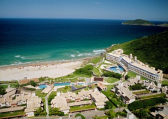
Jhowcs: Costao do Santinho Resort, Florianopolis, Santa Catarina; 2006
Brazil has an extensive coastline with excellent exposure to both the north and southern Atlantic swell trains. Many spots work with swells of multiple directions, which are convenient as regular SE swell which feeds many of the well-known breaks around Santa Catarina, and Littoral Paulista to the south can be fickle.
The entire NE / SW slope of the eastern Brazilian seaboard ensures that any SE swell will produce quality options right along a few thousand kilometres of coastline. Southern Brazil around Santa Catarina does have a more southern aspect and generally superior coastal features that will maximise surfing potential and many surfers choose to base themselves here.
Of late however, a sleepy offshore Brazilian Island to the extreme NE by the name of Fernando de Noronha has been blowing minds with it’s uncrowded northerly breaks which all come to life as the swell trains of the North Atlantic deposit their long period rewards against a series of reefs and points only now gaining international recognition. It doesn’t get any better than that.
travel
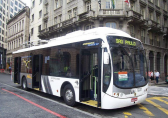
Ailton Florencio: Bus in São Paulo; 30 October 2007
Plane is the easiest way to get to Brazil for most travellers from other continents. The main destinations will be São Paulo or Rio de Janeiro, but there are also flights to Recife, Fortaleza, Natal, and Salvador. Charter tourism flights from Europe often land directly in Salvador, Recife, Fortaleza, and Natal. Direct flights from Sāo Paulo and/or Rio de Janeiro to Lisbon, Madrid, Paris, London, Amsterdam, Frankfurt, Milan and Zurich are also available. North American cities served by non-stop flights to Sāo Paulo include Atlanta, Chicago, Dallas, Houston, Mexico City, Miami (RJ also), Newark, New York, Panama City (RJ also), Toronto and Washington DC (RJ also).
If you are in South America, you can travel by car or bus. Long-distance bus service connects Brazil to its neighbouring countries with the main capitals: Buenos Aires, Asunción, Montevideo, Santiago de Chile, and Lima. Though it can be a problem to find a direct connection from Lima. And also keep in mind that distances are significant, so the road trip may take up to 3 days.
If you go by car, it will be good to know that the connection from Colombia to Brazil has no continuity inside both countries, and traffic is restricted to the twin-cities area (Leticia and Tabatinga).
If you are not in a hurry, you may wish to take a boat - Amazon river boats connect northern Brazil with Peru, Venezuela and Colombia. It will take about 12 days and from French Guiana, you can cross the river Oyapoque, which takes about 15 minutes.
Travelling by train can be more difficult, but if you are ok with that, then take one from Santa Cruz, Bolivia, to a small town just over the border from Corumbá in the State of Mato Grosso do Sul. And from here you will have to take a bus to São Paulo via the state capital, Campo Grande, as a train line is not in use.
Weather
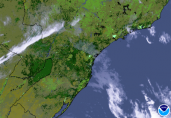
Southern Brazil NOAA GOES-12 Satellite Image
The climate of Brazil is subject to great geographical variation due in part to the fact that it makes up almost 50% of the South American continent and has over 9000 km of coastline extending from 5° N to 34° S. As one would expect in a country that extends so far from north to south, Brazil has many different climatic zones. For coastal areas, the tropic of Capricorn (23°S) runs through Rio de Janeiro so this means, basically a tropical climate extends north from here throughout the year, while south of Rio including Brazil’s most famous surfing state of Santa Catarina (Florianopoluis), the climate is generally subtropical characterised by warm summers and cold winters, though rainfall can occur any time of year. The climate of Brazil is controlled by the northward displacement of polar air masses and associated cold fronts, trade winds that blow all year around originating from the South Atlantic high and the Intertropical Convergence Zone (ITCZ) which varies its position, approaching the coastal zone of northern Brazil during the summer and autumn and moving north, away from the coast, during the winter and spring. Northern Brazil sees more of a wet/dry season oscillation though around the Amazon mouth it is more like wet and wetter seasons, while the for the rest of the country the summer hemisphere four seasons are generally evident: Winter (June-August), Spring (September-November), Summer (December-February) and Autumn (March May).
Winter (June-August)
In winter (Northern Hemisphere summer), the South Atlantic high is at its farthest north position. This allows southern Atlantic cold fronts to be pushed farthest north even influencing condition at latitudes of 10°S. The good news here is that the deep lows associated with these fronts generate large swells that in particular line up well for the south-east facing coasts, making it the preferred time of travel for the experienced surfer. The passage of cold fronts will also give you opportunities for offshore westerlies. However in the south, these systems can also bring with them storms and cooler temperatures. Rain occurs on an average of 6-9 days per month in the south while in the north the main part of the ITCZ has moved offshore though rain occurs mostly year round with 12 days per month. In the south, mean highs are 21 to 23°C throughout the season but can be much cooler behind cold fronts. The mean lows are 14°C all winter, so morning surfs will be mild. North of Rio conditions are consistently warm with mean highs from 26 to 28°C and lows around 20°C.
Spring (September-November)
Spring can produce great conditions in Brazil and is the overall preferred time for travel. Late winter easterly swells can still be prevalent, as the South Atlantic high begins to shift south again, which slowly forces the southern polar fronts south with it. By the end of spring, the fronts associated with southern ocean lows that track west around the planet only reach the southern areas of the country. Rainfall increases in the north from November as the ITCZ moves onshore. Storms become less prevalent in the south though still expect some locally generated showers from moisture bearing onshore trade winds. The prevailing wind tends more and more easterly though the season so morning surfs look more favourable by end season. Rain occurs on average 10-12 days per month in the south, while the north sees from 14-17 days of rain. Temperatures see steady increase to summer maximums with mean highs rising 21 to 26°C, and mean lows 15 to 19°C.
Summer (December-February)
A regional feature of the ITCZ that is important is the South Atlantic convergence zone (SACZ). The SACZ is an elongated convective band typically originating in the Amazon basin, extending toward southeast Brazil, and is active during summer. The South Atlantic high is at its southernmost position of the year and constant easterlies trades prevail over most of the coastline. These winds are often amplified by the sea breezes, so the surf board gets put away by noon in place of caipirinhas, music and party. Rain occurs on an average of 12 days per month in the south, while the SACZ sees upwards of 15 days of rainfall per month in the north. The mean highs are 26°C to 28°C in the south, while the north is a bit hotter, cracking 30°C in January and February.
Autumn (March-May)
As the South Atlantic high shifts northward toward its winter position, temperatures cool in the south as and the southern cold fronts gradually move north. This allows more and more fronts associated with lows in the southern ocean to reach further north in the country, and preferred surfing conditions are on offer again later in the season. The prevailing winds continue come from the east, though westerlies do return with the passage of fronts. Rainfall in the north continues at 15 days per month, while in the south rain occurs on an average of 10 days in the first month of the season to 8 days in May. The mean highs in the south are 26°C in March but drop to 22°C by May, while the lows decrease from 19 to 15°C. In the north, the mean highs area stable 28°C and the lows hover around 20°C.
where to stay
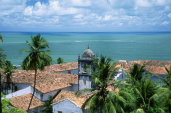
Olinda - Pernambuco - Brazil (from wikitravel.org)
Brazil offers a great variety of accommodation depending on your budget and taste. You will find there absolutely everything from a luxury beach resorts to youth hostels. Pousada (guesthouse) is an option if you are looking for an affordable accommodation. No room service, but most of them offer common meals.
When going to the wild areas, stay in fazendas (ranches with guest facilities/farm hotels). If you are looking for a new experience, a boat hotel can be a great thing to try. The boats are large, safe and comfortable; and they will take you to the most inaccessible places on the rivers and lakes. There are also some small boats, tied to the main one, which can take you to the best “points”.
Just make sure you book in advance if you plan to go in a peak season, which follows the school holiday's calendar, December and January (summer). New Year, Carnival (moveable between February and March) and Holy week are busy as well. Prices will skyrocket, especially in coastal cities like Rio and Salvador.
Yes, and just to let you know - motel is the local term for a "sex hotel", so be aware of the implication, guys.
what to pack
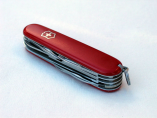
Jonas Bergsten: Victorinox Swiss Army knife closed; 12 June 2005
Pack light when travelling to Brazil. There's no need to bring your expensive belongings, as the country on the whole, is very laid back and casual.
Going to a sunny country, especially in the warm season or to the north coast, which is not far from Ecvator, make sure you take a good sunscreen (SPF 30+); a good insect repellent wouldn't hurt much either. Bring on the medicines you are used to take. Comfortable walking shoes, spare fins, leashes, wax.
dangers and warnings
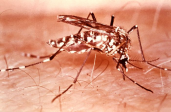
Dwaipayanc; Mosquito; 03.04.2006
Brazil is notorious for it's violent street crimes and theft so vigilance is key here. I've heard of friends getting sunglasses stolen off their face in Rio, in broad daylight, I tell you anything not nailed down.....
As with everywhere, common sense and an acquired travel streetwise approach prevails here. Avoid flashing your shiny new camera around, keep money separated about your person i.e. coins and low denomination notes in you wallet and pockets to hand, larger amount stashed in under clothing in money belts etc. Avoid poorer out city suburbs and dark alleys at night. Try not to travel alone, especially at night or appear intoxicated in public. Traffic in big cities can be a danger, use your eyes and ears. Stick to those basic golden rules and you shouldn't go far wrong.
Don't bother with the tap water, drink bottled water it's way safer and make sure the seal on the bottle is unbroken.
Also, at time of writing reports of a yellow fever breakout are coming in so check with your doctor about the latest situation well in advance of departure.
restaurants, shopping and nightlife

Cachaca Dave; Caipirinha, the national drink of Brazil; 14.03.2007
The national dish of Brazil is the feijoada, it's a heavy stew made from black beans, pork, sausage and beef, it's generally served with rice and greens and sometimes wedges of orange. The seafood in the coastal towns can be exquisite and usually served fresh from the boats that morning, a well tasty snack.
Churrasco is Brazilian barbeque, and is usually served "Rodizio" ou "espeto corrido" (all-you-can-eat). Waiters carry huge cuts of meat on steel spits from table to table, and carve off slices onto your plate (use the tongs to grab the meat slice and don't touch the knife edge with your silverware to avoid dulling the edge). Traditionally, you are given a small wooden block coloured green on one side and red on the other. When you're ready to eat, put the green side up. When you're too stuffed to even tell the waiter you've had enough, put the red side up... Most churrasco restaurants also serve other types of food, so it is safe to go there with a friend that is not really fond of meat.
The Brazilian beer pedigree tends to be quite good due to its Germanic influence; the most common and best brands are Brahma, Skol and Bavaria. A common liquor served in most bars is cachaça, it's made from sugar cane and tastes like ...... it's and acquired taste - if you like gasoline!! The best way to drink it is in the form of a cocktail known as a caipirinha where it is mixed with lime juice and sugar, still potent but drinkable.
what to do when it's flat

Alan Betensley; Rio Carnival; 2004
If you happen to be here at the beginning of August then the Rio de Janeiro carnival is the must do activity. It takes place on the 1st of April every year and is considered to be one of the greatest shows on earth. The Latin spirit, colour, grandure, music, and in your face good feeling with have you shakin' that tail feather all through the night and well into the next day!
If that's just not your scene, or your not here at the right time the there are plenty of adventure activity companies that will see you right for diving, sailing, canoeing, 4x4 off-roading, horse riding, you name it we do it, type stuff.
If you find yourself in Rio, another good touristy must do is to take the trip up the Corcovado Mountain to visit the 39.6 (130ft) tall "Christ the Redeemer" statue, religious or not it's impressive.
useful phrase guide

Indolences; Standard question mark; 04.05.2007
Unlike all the other South American countries whose official language is Spanish, Brazil's is actually Portuguese, so here at SurfingAtlas we've done our research and found some local lingo to get you on your way:-
Bom dia Good morning
Boa tarde Good afternoon
Ola Hello/Hi
Como Esta? How are you?






